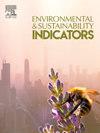The importance of the mobilization and transformation of phosphorus flow knowledge in the agro-food sector through the Substance Flow Analysis (SFA) method
IF 5.4
Q1 ENVIRONMENTAL SCIENCES
引用次数: 0
Abstract
Decision makers frequently choose to investigate P management independently for crop production or food consumption without considering the advantages of including other indicators in the final decision. This study analyzes phosphorus (P) flows in agro-food systems through Material Flow Analysis (MFA). The objective is to identify critical points of P loss and opportunities for recovery, considering geographical and socioeconomic contexts. The focus is on integrating technological, policy, and management approaches to sustainably close the P cycle. The possibility of the SFA method for Substance P and other interfering variables in agricultural and food production systems is investigated in this research. Substance Flow Analysis (SFA) has become widely used in the analysis of nutrients such as phosphorus (P) and nitrogen (N) in the municipal sector and agricultural activities. The P management concept report could have a significant impact on long-term sustainability prospects. The authors have used three major themes to increase the scientific corpus search of the occurrence of the P cycle in agri-food systems: perturbations in the P trace, the chances of P recovery drivers, and the relationship of sustainable approaches to the development of the P cyclical cycle. This research offers new perspectives for decision makers, particularly policy makers, regulators, agriculture and industry stakeholders, and society, in the context of macro, meso and micro level solutions. Improved P nutrient recovery efficiency and repair of ' four broken points' along the P circular cycle in agri-food systems are required with a better grasp of how to manage P flow control.
通过物质流分析(SFA)方法在农业食品部门调动和转化磷流知识的重要性
决策者经常选择独立调查作物生产或食品消费的磷管理,而不考虑在最终决策中纳入其他指标的优势。本研究通过物质流分析(MFA)分析了磷(P)在农业粮食系统中的流动。目标是在考虑地理和社会经济背景的情况下,确定磷损失的临界点和恢复的机会。重点是整合技术、政策和管理方法,以可持续地关闭P周期。本研究探讨了SFA方法在农业和粮食生产系统中检测P物质和其他干扰变量的可能性。物质流分析(SFA)在市政部门和农业活动中已广泛应用于磷(P)和氮(N)等营养物质的分析。P管理概念报告可能对长期可持续性前景产生重大影响。作者使用了三个主要主题来增加农业食品系统中P循环发生的科学语料库搜索:P痕迹的扰动,P恢复驱动因素的机会,以及P循环循环发展的可持续方法的关系。本研究为决策者,特别是政策制定者、监管机构、农业和工业利益相关者以及社会提供了宏观、中观和微观层面解决方案的新视角。提高磷养分回收效率和修复农业食品系统中磷循环的“四个断点”,更好地掌握如何管理磷流控制。
本文章由计算机程序翻译,如有差异,请以英文原文为准。
求助全文
约1分钟内获得全文
求助全文
来源期刊

Environmental and Sustainability Indicators
Environmental Science-Environmental Science (miscellaneous)
CiteScore
7.80
自引率
2.30%
发文量
49
审稿时长
57 days
 求助内容:
求助内容: 应助结果提醒方式:
应助结果提醒方式:


